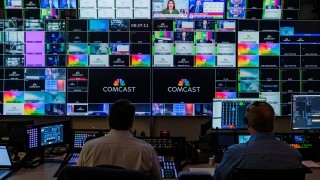Live sports video: A winning playbook for content delivery and management
October 18, 2024
For streaming, broadcasting, or advertising, live sports represent some of the most exciting and most complex events to manage — and some of the most lucrative, particularly when it comes to breaking into new markets.
But when you’re only live once, the pressure to deliver flawless real-time content is immense, and the coordination required between technology, vendors, and teams is absolutely critical to bring home the win. As part of our Content Circle of Life series, Bill Calton, VP of Operations for Comcast Technology Solutions, sat down with David Wilburn, Vice President of TVE & VOD Software Engineering, Peacock, and Jorge de la Nuez, Head of Technology and Operations at the Olympic Channel, to discuss some of the key aspects of delivering/managing live sports content.
Read the highlights below or watch the full conversation here for expert perspectives on some of the most critical topics in live sports media, including:
- Vendor/technology partner selection
- AI in sports
- Infrastructure challenges
- The role of social media and advertising
The importance of vendor selection in live sports video
Bill Calton, VP of Operations, Comcast Technology Solutions: We’ve just been through the 2024 Summer Olympic Games in Paris, where over 3 billion viewers consumed some portion of this event’s content globally. And we all know that when we prepare for live sporting events, like the Olympics, we often work without a net.
What is your process for getting a vendor in place prior to these events?
Jorge de la Nuez, Head of Technology and Operations, Olympic Channel:
- Vendor selection for events like the Olympics is a complex and lengthy process. It often takes years to build relationships with trusted vendors, particularly in such high-stakes environments.
- Auditing and competitive bidding processes are key elements, but personal relationships and knowledge of a vendor's track record are just as important.
- Preparing for an event like the Olympics requires testing for load capacity and auditing the entire ecosystem to ensure no part of the infrastructure can fail.
David Wilburn, Vice President of TVE & VOD Software Engineering, Peacock:
- Vendor relationships are critical, but so is ensuring they are true partners who understand the needs of the business and adapt to them.
- It’s important to choose partners who are innovators and are evolving alongside the business, not just following their own roadmaps.
- Partnerships should be flexible and scalable, with real-time communication that allows for quick issue resolution.
The role of AI in live sports content management and delivery
The possibilities seem endless in terms of how people consume sports content, from where they're consuming it to what type of device they're consuming the content on. And we're starting to see AI tools be leveraged to support this.
How have you seen AI play a role in the live sports media arena?
David Wilburn, Peacock:
- AI is beginning to assist in automating sub-clipping for highlights and identifying players using jersey numbers or facial recognition. However, these systems are still evolving, so it will be interesting to see how this continues to develop. One of the challenges in leveraging AI for live video streaming is latency, especially in high-stakes environments like sports betting, where near-zero latency is a must.
Jorge de la Nuez, Olympic Channel:
- AI has been integrated into Olympic content since Tokyo 2020, particularly in highlight creation and video content management.
- AI tools are really useful for generating short-form video content for social media and search platforms
- On the back end, AI helps home in on user profiling and content recommendation, which is driven by data analytics.
Infrastructure to ensure reliability for sports video
When the lights come on and fans tune in, your infrastructure needs to be ready. When you’re only live once, you need to effectively deal with redundancies, both from a cloud or on-premises perspective.
What do you do to ensure that these events go off without any interruption?
Jorge de la Nuez, Olympic Channel:
- Managing infrastructure for the Olympics is a blend of cloud-based and on-premises systems. While the cloud offers flexibility, there are still challenges with cost and multi-vendor coordination.
- Keeping the infrastructure simple when possible and relying on trusted partners for redundancy helps us manage complexity when the stakes are high.
David Wilburn, Peacock:
- Having active-active multi-region services and auto-detection of issues is critical for high uptime, particularly during events like the Olympics or NFL games.
- Chaos and load testing are essential to ensure that the systems can handle the massive demand of live events. Multi-CDN strategies also ensure that content delivery is never interrupted.
Social media, branding, and advertising for live sports content
People are grabbing sports content and leveraging it on their own social media.
Are you seeing any trends in advertising related to live sports that you think would be relevant?
Jorge de la Nuez, Olympic Channel:
- The International Olympic Committee has integrated social media platforms like YouTube into its distribution strategy. It’s a balancing act between delivering free content and driving audiences to their own platforms.
- At the same time, branded content is becoming more important than traditional ads, particularly on digital and social platforms.
David Wilburn, Peacock:
- Advertising is changing. We’re going to be seeing a lot more of the use of "squeeze-back" ads, where video continues to play while ads are displayed on the screen. This allows viewers to stay engaged with live sports while still being exposed to relevant content from advertisers.
As the live sports media landscape continues to evolve, so will the technologies that support it. At the same time, the importance of strong partnerships and well-prepared teams cannot be overstated. If you’re looking for a teammate to help you adapt, innovate, and maintain excellence in sports content delivery and management, connect with us here.






